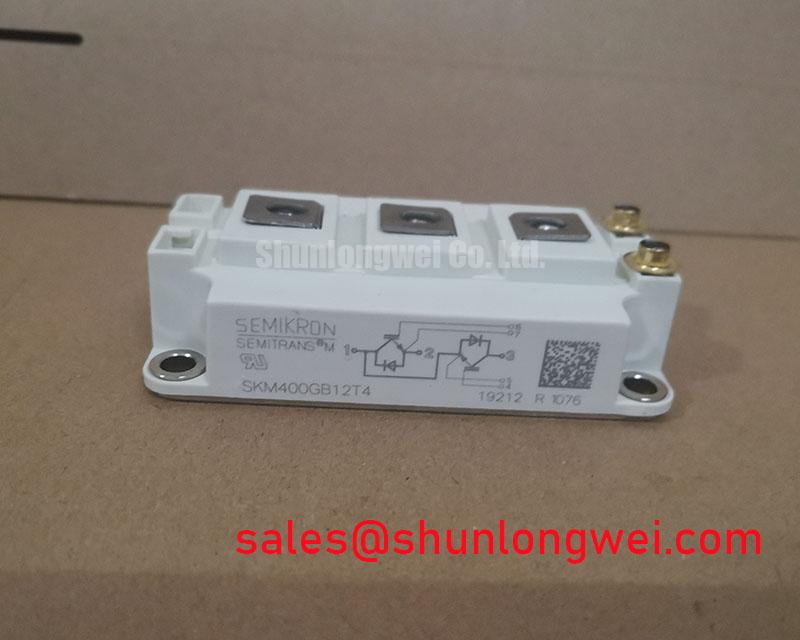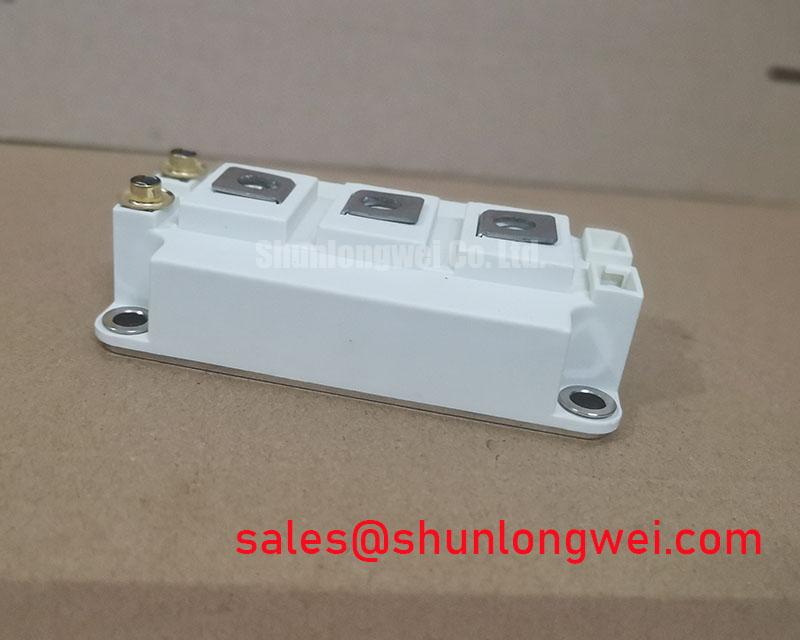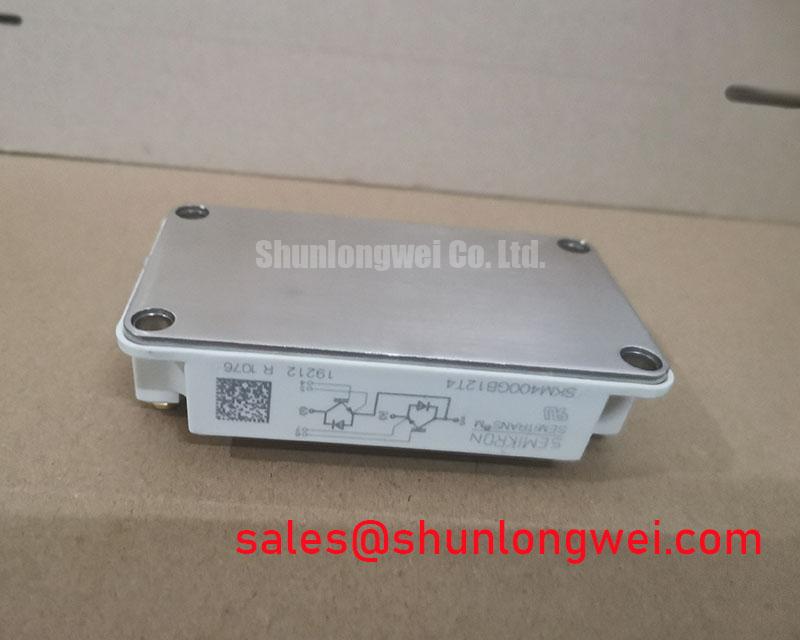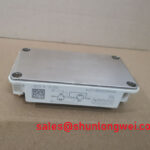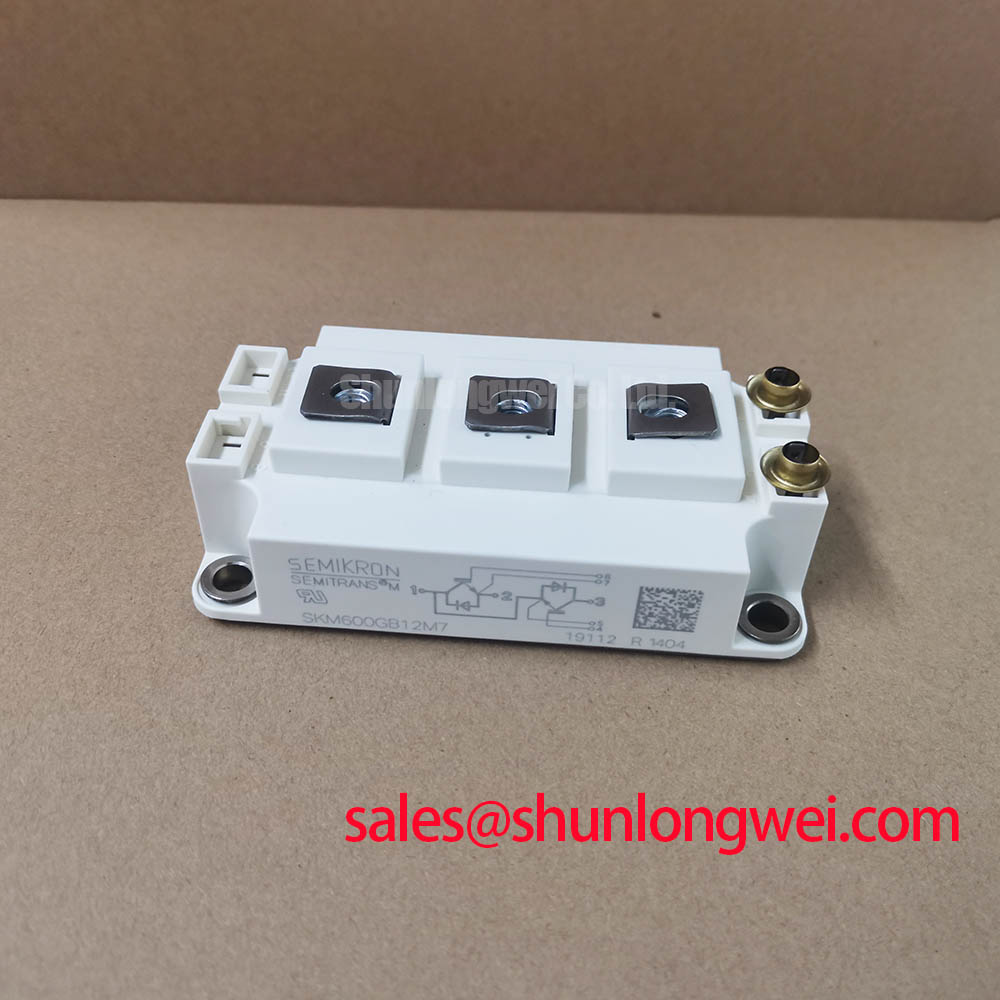Content last revised on November 16, 2025
SKM400GB12T4 IGBT: Low-Loss 1200V High-Frequency Switching
Engineered for high-frequency power conversion, the Semikron SKM400GB12T4 leverages Trench Gate IGBT4 technology to minimize thermal load and maximize system efficiency. This half-bridge module provides a robust foundation for demanding inverter designs.
At the core of modern power electronics, the principle of minimizing energy loss during conversion is paramount. The SEMITRANS 2 IGBT Module SKM400GB12T4 is designed specifically around this principle, integrating advanced silicon technology to reduce both conduction and switching losses. Key specifications include: 1200V | 400A | VCE(sat) 1.7V (typ). This focus delivers two primary engineering benefits: superior system efficiency and reduced thermal management requirements. For engineers designing systems like Variable Frequency Drives (VFDs) or solar inverters, the module's low VCE(sat) and optimized switching characteristics provided by the Trench Gate chip directly translate into lower operational costs and higher power density.
The Efficiency Imperative: How Low-Loss Modules Shape Modern Power Systems
In an industrial landscape driven by mandates for energy efficiency and reduced carbon footprints, the performance of power semiconductors is under intense scrutiny. The SKM400GB12T4 directly addresses these trends by employing technologies that cut down energy waste at the source. The combination of a fast trench IGBT4 chip and a soft-switching CAL4 diode results in lower total power dissipation, particularly in applications operating at higher switching frequencies up to 20 kHz. This efficiency enables designers to meet stringent energy standards and can lead to a tangible reduction in the total cost of ownership by diminishing the need for oversized, complex cooling systems. The move towards more compact yet powerful inverters relies heavily on such thermally efficient components.
Data-Informed Evaluation: SKM400GB12T4 vs. Alternative Topologies
When selecting a power module, design engineers must weigh multiple parameters based on application-specific priorities. The SKM400GB12T4, configured as a half-bridge, is a foundational building block for 2-level and 3-level inverter topologies. To support your evaluation, consider a factual comparison with a chopper configuration like the SKM400GAR12T4. While both may share the same voltage and nominal current ratings, their internal circuitry dictates their use. The half-bridge SKM400GB12T4 is ideal for creating inverter legs, whereas a chopper module is designed for applications like DC-DC converters or brake circuits. The choice depends entirely on the required circuit function, and having distinct, optimized modules for each role prevents design compromises.
Anatomy of Efficiency: Trench Gate 4 and CAL Diode Synergy
The performance of the SEMITRANS 2 IGBT Module SKM400GB12T4 is rooted in two key semiconductor innovations:
- Trench Gate IGBT4 Technology: This structure creates a vertical gate, increasing cell density and significantly lowering the collector-emitter saturation voltage (VCE(sat)). Think of VCE(sat) as a "voltage toll" the current must pay to pass through the switch when it's on. A lower toll, like the 1.7V typical VCE(sat) of this module, means less energy is converted into heat, directly boosting conduction efficiency.
- CAL4 Freewheeling Diode: The integrated Controlled Axial Lifetime (CAL) diode is engineered for "soft" recovery. This means it transitions from conducting to blocking state with minimal voltage overshoot and oscillation, reducing electromagnetic interference (EMI) and protecting the IGBT during turn-on. What is the key benefit of the CAL 4 diode? It enables soft and fast-switching performance, crucial for reliability in high-frequency circuits.
Together, these technologies create a synergistic effect, enabling the module to switch high currents efficiently while maintaining robust electrical and thermal stability. For further reading on IGBT characteristics, the resource "Decoding IGBT Datasheets: A Practical Guide for Engineers" offers valuable insights.
Technical Queries on SKM400GB12T4 Performance
Q1: How does the VCE(sat) of the SKM400GB12T4 change with temperature?
The SKM400GB12T4 is designed with a positive temperature coefficient for VCE(sat). At a nominal current of 400A, the typical VCE(sat) is 1.7V at 25°C, increasing to 2.05V at a junction temperature of 125°C. This characteristic is highly advantageous for paralleling modules, as it naturally promotes current sharing and prevents thermal runaway in one device.
Q2: What are the thermal design implications of the specified Rth(j-c)?
The datasheet specifies a thermal resistance from junction to case (Rth(j-c)) of 0.11 °C/W per IGBT. This value is a critical metric for heatsink design. It quantifies how effectively heat generated at the silicon chip can be transferred to the module's baseplate. A lower Rth(j-c) indicates more efficient heat transfer, allowing for a smaller heatsink or greater operational margin under heavy thermal loads. For a deeper understanding, refer to this guide on unlocking IGBT thermal performance.
Q3: What makes the integrated CAL 4 diode suitable for fast switching?
The CAL 4 (Controlled Axial Lifetime) diode technology is specifically engineered for soft and fast recovery characteristics. During the IGBT's turn-on, the freewheeling diode must turn off quickly. A standard diode might do so abruptly, causing high voltage spikes and EMI. The CAL 4 diode's "soft" recovery minimizes these overshoots, ensuring smoother operation and enhanced reliability, which is particularly important in systems switching at frequencies up to 20 kHz.
System Spotlight: Reducing Thermal Overhead in VFDs
In a high-power Variable Frequency Drive (VFD), the inverter stage is a primary source of heat. Deploying the SKM400GB12T4 in this stage can lead to a more compact and reliable system. Its low switching and conduction losses mean less waste heat is generated for a given output power. This reduces the burden on the cooling system, potentially allowing for a smaller, lighter heatsink or a lower-speed fan, which in turn saves space, cost, and audible noise. This thermal efficiency is a direct result of its advanced IGBT4 and CAL4 diode technologies.
Deploying Efficiency in High-Demand Power Applications
The robust electrical characteristics and high thermal efficiency of the SEMITRANS 2 IGBT Module SKM400GB12T4 make it a suitable component for a range of high-power conversion systems. Its design ensures dependable operation in applications where performance and long-term reliability are critical. What is the module's primary design goal? To provide reliable power switching with minimal energy loss. Key deployment areas include:
- AC Inverter Drives: The module's capacity to handle 400A nominal current and its fast, efficient switching are ideal for controlling high-power industrial motors.
- Uninterruptible Power Supplies (UPS): In large-scale UPS systems, efficiency is key to minimizing operating costs. The low VCE(sat) of the SKM400GB12T4 contributes directly to a higher efficiency inverter stage.
- Electronic Welding Systems: The module supports high switching frequencies (up to 20 kHz), enabling the design of advanced, stable welding power sources.
- Renewable Energy Inverters: In solar and wind power applications, maximizing the conversion efficiency from DC to AC is paramount. This module helps achieve higher energy yields.
For applications demanding high current handling and fast switching up to 20kHz, the SKM400GB12T4's combination of low VCE(sat) and CAL4 diode technology makes it a strong contender.
SKM400GB12T4 Core Performance Metrics
This table highlights the essential parameters for system design and evaluation. For a complete list of specifications, electrical characteristics, and thermal performance graphs, please refer to the official datasheet.
| Parameter | Value |
|---|---|
| Collector-Emitter Voltage (Vces) | 1200 V |
| Nominal Collector Current (Ic,nom) | 400 A |
| Collector-Emitter Saturation Voltage (VCE(sat), typ. @ 400A, 125°C) | 2.05 V |
| Total Switching Energy (Eon+Eoff, @ 125°C) | 127 mJ (typ) |
| Thermal Resistance, Junction to Case (Rth(j-c), per IGBT) | 0.11 °C/W |
| Short Circuit Withstand Time (tpsc) | 10 µs |
As power conversion technologies advance, the focus on increasing power density and operational efficiency will only intensify. Modules like the SKM400GB12T4, which integrate loss-reducing technologies directly into the silicon, represent a strategic asset for designers. By building systems on such efficient foundations, engineers can not only meet today's performance and regulatory demands but also create more scalable and cost-effective platforms for future product generations.

